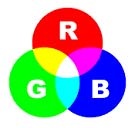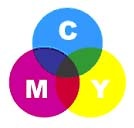Color 101
Why doesn’t the color on my computer monitor look like the proof or my printed job?
Primary Colors |
Light & Color As we all learned in elementary school, the primary colors are Red, Blue & Yellow. These colors refer to pigment and paint, rather than the light spectrum; in fact the primary colors of the light spectrum are Red, Green & Blue. The reason objects appear as a certain color is because they absorb some colors and reflect others. Hence, a blue object appears blue because it is absorbing green and red light and reflecting blue toward the eye. |
||||||||||||||||||
 RGB light combine to make white |
Computer Monitors (RGB) & Color Digital cameras, scanners, and computer monitors generate colors based on RGB (Red, Green & Blue). These colors are created by adding light to change a black appearing screen. Screen color is called additive color because light is added to create color. |
||||||||||||||||||
 CMYK inks combine to create black |
Process Printing (CMYK) & Color 4 color process printing uses reflection of certain colors until a desired color is visible. Process printing is called subtractive color because inks are used to partially block the reflection of light. Commercial printing presses use different percentages of Cyan, Magenta, Yellow, & Black (CMYK) ink to create or “build” color. It is often times called screened color because screens of each color are used to create a new color. Because process colors are built from two to four inks, they may at times look murkier than spot color. Some spot colors are impossible to render through process (CMYK) color. |
||||||||||||||||||
  RGB Color CMYK Color |
RGB Spot Compared To CMYK Spot Color Your computer monitor can create colors that cannot be reproduced in print. A conversion of your RGB files to CMYK is necessary before printing process color. When selecting colors for your print project, we recommend using CMYK spot color builds to avoid potential RGB conversion issues. |
||||||||||||||||||
|
Pantone Spot Colors The most popular color matching system used by the printing industry to print spot colors is the Pantone Matching System also known as Pantone colors. Ink is mixed using exact measurements determined by the Pantone color system to create a specific color. This assures that you get the right color when the file is printed, even though the color may not look right when displayed on your monitor. If your job is not printing four-color process, we will ask you for a Pantone number to guarantee the look you want. If necessary, ask to look at one of our Pantone Color books to verify your spot ink color. Most applications that support color printing (i.e. Quark, InDesign, Illustrator, Photoshop) allow you to specify colors by indicating the Pantone name or number. Be aware that when converting Pantone colors to CMYK for printing, not all colors reproduce accurately. Also there are many different conversion tables available for converting Pantone color to CMYK. Consider this when designing your print job. |
Remember, never judge color based on what it looks like on your computer monitor.
The incompatibility of screen color and printed color is a major issue and should be resolved prior to putting your job into print production.




